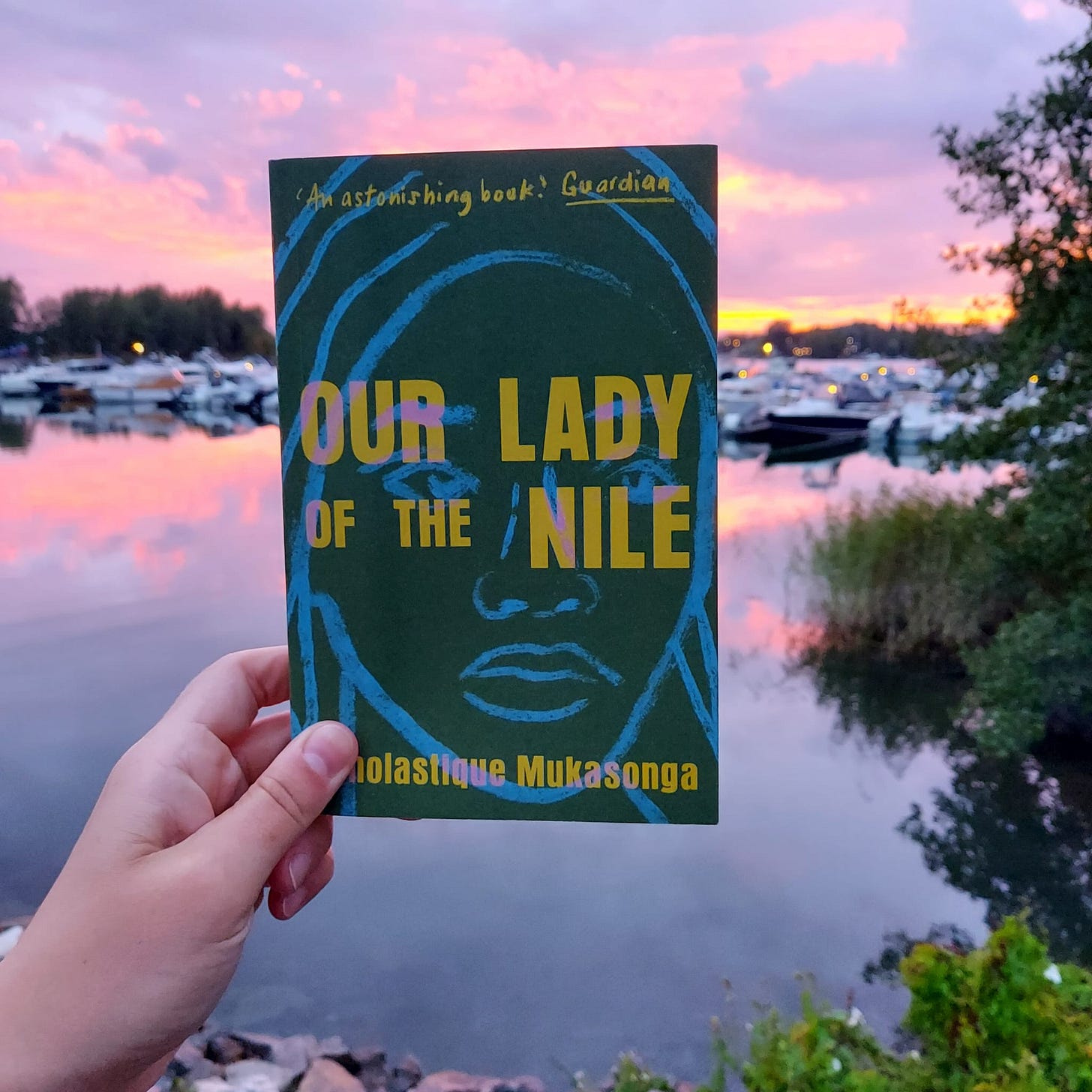Welcome to Bookmarked, a weekly newsletter following my journey as I read one book from every country. If you like the sound of my project, I’d love it if you shared Bookmarked with a friend.
Set in the late 1970s in an elite lycée in the Rwandan mountains, Scholastique Mukasonga’s Our Lady of the Nile paints a horrifying picture of how the era’s anti-Tutsi hate speech set Rwanda’s two main ethnic groups, the Hutu and the Tutsi, against one another in the years preceding the genocide. Mukasonga herself grew up in Rwanda, settling in France just two years before the anti-Tutsi massacres that engulfed her homeland in 1994. In the aftermath of the genocide, she learned that 37 members of her family had been murdered.
In Mukasonga’s novel, a boarding school for Catholic girls called The Lady of the Nile serves as a microcosm of Rwanda. Though Rwanda gained independence in 1961, its government and church maintained strong ties to Belgium, its colonial ruler which continued to exacerbate tensions between the Hutu and the Tutsi. At the time of Our Lady of the Nile, the country is made up of a Hutu majority and a Tutsi minority.
The lycée is ostensibly a part of the government’s efforts to promote female education in Rwanda. Its students are taught by Belgian nuns and priests who immediately make it known that “History meant Europe, and Geography Africa.” Students are given European foods and banned from speaking anything but French.
… the only language permitted within the grounds of the lycée was French, except in Kinyarwanda classes of course, but only in class, and nowhere else. Once they married men in positions of high office (and why shouldn’t some of the girls end up holding such positions too?), they would be required to use French as their main language. And above all, it was forbidden to utter a single word of Swahili in the lycée, which had been placed under the patronage of the Virgin Mary, for it was a deplorable language, that of the followers of Muhammad.
Through linked chapters that focus on individual characters in turn, Mukasonga explores the roots of the politically manufactured tensions that led to the 1994 genocide. Among the students we meet are Gloriosa, the daughter of a Hutu politician who parrots her father’s anti-Tutsi sentiments; Immaculée, a Hutu who is considered unusual for befriending her Tutsi classmates; Modesta, who is of mixed Hutu and Tutsi heritage; and Veronica and Virginia, two Tutsi girls who have been admitted to the lycée to fill the required quota of Tutsis. The book’s adult characters include Father Herménégilde, a priest who sexually abuses his students, and Monsieur de Fontenaille, a recluse who believes the Tutsi are descendents of the ancient Egyptians and are thus worthy of worship.
Mukasonga does a fantastic job of portraying the rising tensions between Tutsi and Hutu students. Early on, the girls argue about the proper way to cook bananas, with Virginia making the case that they’re best grilled straight out of the fields. “So what did you come to the lycée for?” asks Gloriosa. “You should have stayed in the sticks munching bananas in the fields. You would have made room for a real Rwandan from the majority people.” As the story continues, the girls’ disputes become even more sinister. One day Gloriosa decides that the school’s statue, a black Virgin Mary, has a “Tutsi nose” and takes it upon herself to replace it. When she accidently breaks the statue, Gloriosa invents a lie about being attacked by Tutsi militia. Unsurprisingly, this fuels hostility toward the lycée’s Tutsi students.
At times Mukasonga’s authorial voice is a little pedagogical, but in my opinion that’s no bad thing. In providing plenty of historical and cultural context, Mukasonga offers a balanced exploration of the mythological, Biblical, and colonial reasoning that led to the belief that Tutsis are not “real” Rwandans. The result is a violent, disturbing, moving take on a coming-of-age novel, which offers a glimpse into Rwanda’s history. I’ll be thinking about Our Lady of the Nile for a long time.
Our Lady of the Nile by Scholastique Mukasonga, translated by Melanie Mauthner (Archipelago Books, 2014 / Éditions Gallimard, 2012)
More books by Rwandan authors:
Here is a short list of other books by authors from Rwanda:
Teta by Barassa
The Past Ahead by Gilbert Gatore, tr. Marjolijn de Jager
Left to Tell by Immaculée Ilibagiza with Steve Erwin
Cockroaches by Scholastique Mukasonga, tr. Jordan Stump
Igifu by Scholastique Mukasonga, tr. Jordan Stump
The Barefoot Woman by Scholastique Mukasonga, tr. Jordan Stump
Not My Time to Die by Yolande Mukagasana, tr. Zoe Norridge
The Girl Who Smiled Beads by Clemantine Wamariya and Elizabeth Weil
What have you read recently?
If you’ve read a brilliant book in translation or you’d like to pass on a recommendation, I’d love to hear about it! For this project, I’m focussing on contemporary fiction and short stories, with a preference for female authors—but I’m always happy to venture further afield for a good recommendation.
You can get in touch by replying to this email or leaving a comment. I’ll be featuring your recommendations in upcoming newsletters, and I’ll keep a growing list here.
Bookmarked is written by Tabatha Leggett. If you know someone who would enjoy this newsletter, please forward it to them!




